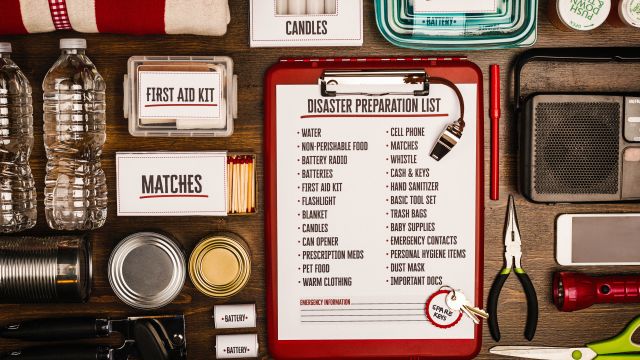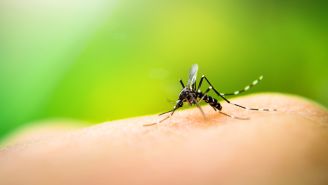Updated on October 19, 2022.
Residents of California, Washington, and Oregon are particularly vulnerable to wildfires. Earthquakes may not occur often in North Dakota and Florida, but they're common in Alaska and Nevada. No matter your location, natural disasters like these, along with tornadoes, landslides, floods, and hurricanes can happen unexpectedly—and having an emergency kit prepared could save a life.
Putting together an emergency kit is an easy and inexpensive way to help ensure your family remains safe and healthy in the event of a tragedy. If you don’t know how to begin building your "go bag," you're not alone. About 65 percent of Americans are unprepared for a disaster, according to a 2015 survey.
Here’s how to pack disaster kits to store at home, plus helpful items to stow in your vehicle.
Build your bag—the basics
Pack emergency items first in clear plastic bags before organizing them in one or two portable bins or bags with handles, such as a duffel bag. The bulk of your items should consist of necessities—think food and water—to last your family at least 72 hours. One gallon of water should last an individual for one day, so stock at least three jugs for each member of your household, and more if you have pets. You should also pack a three-day supply of non-perishable food that doesn’t require heating or cooking.
Nuts and granola bars are good options, as are canned foods like tuna, beans, and vegetables—just remember to pack a manual can opener. In addition to keeping a three-day supply in your emergency kit, the American Red Cross recommends keeping enough food and water to last for two weeks in your home at all times.
Flashlights, wireless phone chargers, and battery-operated weather radios are also essential during and just after a disaster, but don't get stuck without enough batteries; keep the appropriate type stocked at all times to ensure your devices will work.
A first aid kit, typically equipped with gauze, adhesive tape, bandages, antibiotic ointment, and antiseptic wipes, can't replace medical attention for major injuries, but it can be useful in caring for minor bumps, cuts and abrasions. "With gauze, tape and scissors, you can take care of almost any minor wound," says Buck Parker, MD, a trauma surgeon and emergency medicine specialist with St. Mark's Hospital in Salt Lake City, Utah.
Other basic—but important—go bag items include:
- A whistle to signal for help
- Dust masks to filter the air
- Face masks to help prevent the spread of the flu, COVID-19, and other viruses
- Garbage bags and moist towelettes for personal sanitation needs
- A wrench or pliers—Parker recommends a multi-tool with a knife, pliers, screwdriver, and the like
- Blankets
- Matches in a waterproof bag
- Duct tape
- An extra set of car and house keys
Stow specialty supplies
Customize your kit to fit the needs of your family, including any pets. You can also tailor what you choose to pack towards the natural disasters that may occur in your area. Towels, rain gear, and a change of clothes for each family member may be necessities in areas typically hit with wet weather disasters. Keep a supply of baby formula, diapers, wipes, and rash cream if you have young ones. Extra water, canned or dry food, leashes, and carriers are important for any household pets.
Prescription medications and non-prescription drugs like pain relievers and antacids should be packed in a waterproof container, along with a written list of doses, known allergies, your pharmacy’s name and number, and your healthcare provider’s name and number. "If you have high blood pressure or diabetes, that can be a real issue," according to Dr. Parker. A 14-day supply will likely suffice. Going a few days without hypertension medicine can increase your stroke risk. Blood sugar may spiral out of control if diabetics do not have proper treatment, he adds.
Pack important documents including insurance policies, extra cash, and bank records. You may also want to store birth certificates, social security cards, and passports in an easily accessible place, ready to grab in the event of an evacuation. Leave room for glasses, contact lenses, contact solution, and feminine products and non-medical items such as paper, pencils, games, toys, and puzzles to occupy young children.
Maintain your kit
Building your emergency preparedness kit is just the first step. To ensure it’s ready when you need it, give the contents a look every so often. Canned goods should be stored in a cool, dark place and any boxed items stowed in plastic or metal containers away from water, bugs, and rodents. Check expiration dates on food, water, medications, and batteries and replace as needed—Parker recommends doing this once a year. This is a good time also to assess your family's needs, get rid of unnecessary items and add current essentials.
Get your car ready, too
At-home go bags help make evacuating during a disaster a bit easier, without sending you scrambling for the necessities. Keeping your car packed and ready to roll at a moment's notice is also a safe move. The Federal Emergency Management Agency (FEMA) recommends keeping a smaller emergency bag, stocked with survival-essentials like food, water, and a first aid kit, in your vehicle at all times. The vehicle should also contain jumper cables, an ice scraper, flares, and a cellphone charger compatible with your car. Parker recommends a few other items: warm clothes, a fire extinguisher, toolbox, and kit to repair a flat tire.
A well-tuned automobile is also safest for travel. Keep your gas tank full and ensure oil and washer fluid levels meet standard criteria. Invest in good winter tires and get them on your vehicle in accordance with your region's weather patterns. Many of the car's functions can deteriorate overtime, and fail without warning, so periodic inspections of the brakes, battery, exhaust system, and lights are encouraged.
Preparing your home and your car for an emergency is not a difficult task, but it's an important one—even if no natural disaster is on the horizon.







